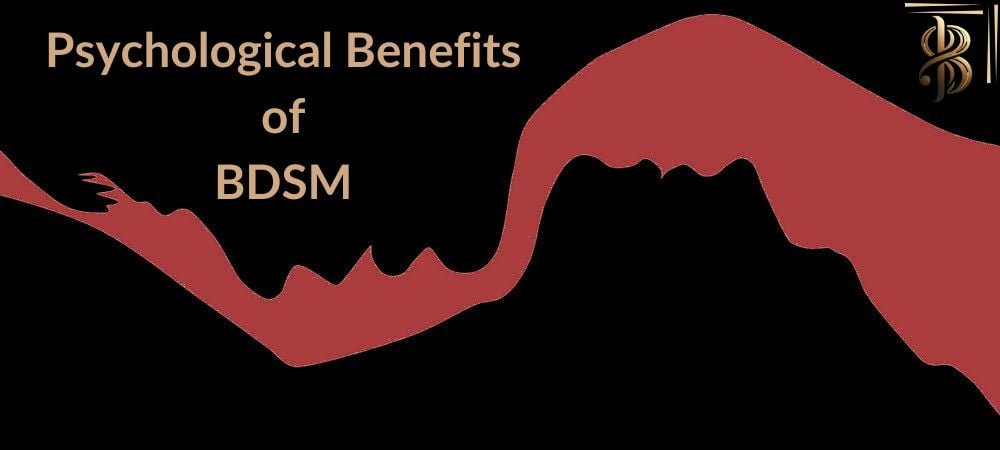
Introduction – Psychological Benefits of BDSM : Exploring BDSM and Its Psychological Impacts
Welcome to a world that’s often misunderstood but deeply intriguing: the world of BDSM. For those stepping into this realm for the first time, or even for veterans seeking a deeper understanding, this article aims to shed light on the often-misconceived practices of BDSM, and importantly, the Psychological Benefits of BDSM.
What is BDSM?
At its core, BDSM represents a variety of practices and modes of interpersonal relationships that are often characterized by their intensity and depth. The acronym itself stands for Bondage and Discipline (BD), Dominance and Submission (DS), and Sadomasochism (SM). It’s a rich tapestry of experiences that extends far beyond what mainstream media often portrays.
Bondage and Discipline: These practices involve the consensual use of physical restraints (like handcuffs or ropes), and the implementation of rules and discipline to control one’s partner. Bondage is not just about physical restraint; it’s about trust and the emotional release that comes with it.
Dominance and Submission: This is more about the power dynamics in play. One partner willingly surrenders control to another, creating a power exchange that is deeply rooted in trust and communication.
Sadomasochism: Here, pleasure is often derived from the infliction or reception of pain, whether physical or emotional. While it may seem extreme, this practice emphasizes safe, sane, and consensual exchanges.
Psychological Effects and Benefits
Delving into BDSM isn’t just about exploring physical boundaries; it’s also about discovering the profound psychological impacts it can have. Contrary to common misconceptions, engaging in BDSM can lead to various psychological benefits:
Increased Trust and Communication: The foundation of any BDSM relationship is trust. Partners must communicate openly and honestly about their desires, limits, and boundaries.
Empowerment and Personal Growth: For many, BDSM is a journey of self-discovery. It empowers individuals to explore their desires and fears in a safe and controlled environment.
Stress Relief and Mental Clarity: Many practitioners find BDSM to be a form of escape, where the roles and rules provide a break from the complexities of everyday life, offering mental clarity and stress relief.
Strengthened Relationships: BDSM can strengthen the bond between partners. The level of vulnerability and trust required can enhance intimacy and understanding.
Exploration of Altered States: Some individuals experience altered states of consciousness, similar to a ‘runner’s high,’ during BDSM activities, leading to feelings of euphoria and deep emotional satisfaction.
As we delve deeper into the intricacies of BDSM, we’ll uncover more about these psychological benefits and how they manifest in the practice of BDSM. Remember, the journey into BDSM is unique for everyone, and it’s all about exploring personal limits and desires in a safe, consensual, and responsible manner.
The Psychological Profile of BDSM Practitioners

When we peel back the layers of BDSM, we uncover a fascinating psychological landscape. BDSM practitioners, often perceived as enigmatic, actually display a range of personality traits that are intriguing and, in many ways, beneficial.
Diverse and Positive Personality Traits
Studies have shown that those who engage in BDSM tend to exhibit certain personality traits that differentiate them from the general population. Notably, BDSM practitioners often have:
Lower Levels of Neuroticism: They generally experience fewer negative emotions like anxiety and sadness. This is particularly significant in a world where mental health challenges are on the rise.
Higher Levels of Extraversion: Many in the BDSM community are outgoing and thrive on social interactions. This extroverted nature can foster a strong sense of community and belonging.
Openness to New Experiences: BDSM practitioners typically score high on openness, reflecting a willingness to explore new ideas, experiences, and personal growth.
Conscientiousness: Surprisingly, a higher degree of conscientiousness is observed among BDSM enthusiasts. This trait relates to being organized, dependable, and disciplined, which is crucial in practices that require a high level of trust and negotiation.
Subjective Well-Being: Overall, studies indicate that individuals engaged in BDSM report a higher level of happiness and satisfaction in their lives, compared to those who do not participate in these practices.
Distinct Traits in Dominants and Submissives
The BDSM community is diverse, with roles ranging from dominants to submissives and switches. Each role aligns with distinct personality traits:
Dominants: Typically, dominants exhibit the lowest levels of neuroticism compared to other groups. This trait aligns well with the demands of their role, which requires confidence and assertiveness. They also tend to have higher subjective well-being, likely stemming from their control and leadership within the dynamic.
Submissives: Contrary to some stereotypes, submissives aren’t necessarily lacking in self-esteem or personal strength. Instead, their role is often a chosen form of expression and empowerment. While they might not score as low on neuroticism as dominants, their role in BDSM is equally fulfilling and important.
Switches: Those who switch between dominant and submissive roles show versatility in their personality traits, often balancing the characteristics of both dominants and submissives.
In conclusion, BDSM practitioners are a diverse group with unique psychological profiles that contribute to their choice and enjoyment of BDSM activities. Understanding these traits not only demystifies BDSM but also highlights its role in personal and psychological well-being. As we continue to explore the world of BDSM, it’s clear that there’s much more to it than meets the eye, with deep psychological underpinnings supporting its practices.
BDSM and Altered States of Consciousness

The exploration of BDSM is not just a physical or emotional journey; it also encompasses unique psychological experiences, particularly in the realm of altered states of consciousness. These altered states, often profound and transformative, play a significant role in the appeal and effects of BDSM activities.
Understanding Altered States of Consciousness
An altered state of consciousness is a mental state that differs significantly from normal waking consciousness. In the context of BDSM, these states are not induced by substances but rather through the intense physical and emotional experiences inherent in BDSM practices. These states can be deeply immersive, offering practitioners a sense of escapism, deep relaxation, or intense focus, vastly different from their everyday experiences.
The Experience of ‘Transient Hypofrontality’ in Bottoms
During BDSM activities, the person in the submissive role, often referred to as the ‘bottom’, can experience what’s known as ‘transient hypofrontality’. This term describes a temporary reduction in the frontal brain’s activity, leading to some fascinating psychological effects:
Reduction in Pain: The altered state can diminish the perception of pain, which is particularly significant in practices involving physical stimulation or restraint.
Feelings of Floating and Peacefulness: Bottoms often report feelings akin to floating, a kind of serene detachment from the usual pressures of life.
Living in the Here and Now: This state encourages a heightened sense of presence, allowing individuals to fully immerse themselves in the moment, free from the typical barrage of thoughts and worries.
The State of ‘Flow’ in Tops
Conversely, the dominant partner in BDSM, or the ‘top’, often enters a mental state known as ‘flow’. This concept, widely recognized in psychology, is characterized by:
Focused Attention: Tops in a state of flow experience a laser-like focus on the activity at hand. This concentration allows for a deep engagement in the practice, enhancing both skill and enjoyment.
Loss of Self-Consciousness: In this state, tops may lose their sense of self-consciousness, becoming wholly absorbed in their role.
Optimal Performance: Flow is often associated with achieving peak performance. In BDSM, this could translate to a heightened ability to read their partner’s reactions and adjust their actions for maximum mutual benefit.
These altered states of consciousness in BDSM are not just mere side effects; they are integral to the experience and appeal of these practices. They allow practitioners to explore parts of themselves that might remain hidden in their everyday lives, offering a unique form of psychological release and fulfillment. As we continue to delve into the complex tapestry of BDSM, it becomes clear that its practices are as much about mental and emotional exploration as they are about physical experiences.
Psychological Benefits and Stress in BDSM

BDSM, often viewed through a lens of physical practices, has profound psychological and emotional dimensions. Among these, the enhancement of relationship closeness and the modulation of stress are particularly noteworthy.
Enhanced Relationship Closeness
One of the most striking psychological benefits of BDSM is the way it can enhance the closeness between partners:
Deepened Trust and Intimacy: BDSM requires a high level of trust, open communication, and mutual respect. These requirements naturally lead to a deepening of intimacy between partners. The shared vulnerability and the experiences of giving and receiving control can foster a unique bond.
Improved Communication: The necessity of negotiating scenes and discussing boundaries and limits fosters a level of communication that can spill over into other areas of the relationship, enhancing overall interaction and understanding.
Shared Experiences: Engaging in BDSM activities together can create shared experiences that are both intense and intimate, strengthening the connection and shared identity between partners.
Reduction in Psychological Stress
BDSM activities also offer an avenue for stress reduction :
Escape from Daily Stresses : Engaging in BDSM can provide a temporary escape from everyday life. This escapism can be a significant stress reliever, allowing individuals to take a break from the pressures of daily responsibilities.
Release of Endorphins : The physical aspects of BDSM, such as impact play, can trigger the release of endorphins, the body’s natural painkillers, which can induce feelings of euphoria and well-being.
Empowerment and Control : For many, the control exerted in a BDSM scene, whether as a dominant or submissive, can be empowering. This sense of control can be particularly stress-relieving, especially for individuals who may feel they lack control in other areas of their lives.
Physiological Stress Responses
Interestingly, the psychological stress relief experienced in BDSM does not always align with physiological stress responses, especially in bottoms :
Increases in Physiological Stress for Bottoms : Studies have shown that bottoms can experience an increase in physiological stress, as indicated by elevated cortisol levels during a BDSM scene. Cortisol, often referred to as the stress hormone, can rise in response to physical or emotional stress.
Complex Stress Dynamics : This increase in physiological stress in bottoms does not necessarily negate the psychological benefits. Instead, it highlights the complex dynamics of BDSM, where psychological relief and physiological stress can coexist and contribute to the overall experience.
In sum, BDSM activities can significantly impact psychological well-being and stress levels. The increased closeness between partners, improved communication, stress relief, and the complex interplay of psychological and physiological stress responses all contribute to the multifaceted of physiological benefits of BDSM practices. This complexity not only challenges common misconceptions about BDSM but also underscores its potential as a meaningful and beneficial element in participants’ lives.
BDSM as Recreational Leisure

The perception of BDSM has undergone a significant transformation over the years. From being seen as a taboo or a manifestation of psychopathology, it is increasingly being recognized as a form of recreational leisure. This shift in perception is crucial in understanding BDSM in the modern context.
BDSM : A Form of Recreational Leisure
Consensual and Pleasurable : Modern perspectives on BDSM emphasize its nature as a consensual and pleasurable activity. Participants engage in BDSM for various reasons, including personal enjoyment, exploration of fantasies, and emotional fulfillment. This aligns more with the characteristics of recreational activities rather than psychopathological processes.
Empowerment and Exploration : Rather than being an expression of underlying psychological issues, BDSM can be a means of empowerment and self-exploration. It offers a safe space for individuals to explore their limits, desires, and identities, much like any other hobby or leisure activity.
Stress Relief and Relaxation: Just as some people might unwind through sports, reading, or other hobbies, many find relaxation and stress relief through BDSM. This recreational aspect highlights its role in enhancing personal well-being, akin to other forms of leisure activities.
Contrasting with Historical Views
Historically, BDSM was often misunderstood and pathologized :
Pathologization in the Past : In the past, BDSM was often seen through a medical or pathological lens. It was misconstrued as a symptom of mental disorder or trauma, and participants were often stigmatized.
Shift in Perception : Over time, with better understanding and research, the perception of BDSM has shifted. The American Psychiatric Association, for instance, has revised its stance in the Diagnostic and Statistical Manual of Mental Disorders (DSM), now recognizing that consensual BDSM activities are not inherently pathological.
Normalization and Acceptance : Today, BDSM is increasingly being normalized and accepted as a part of human sexual expression. This is evident in the growing visibility of BDSM in media, literature, and public discourse.
In essence, the modern view of BDSM as a form of recreational leisure is a significant departure from its historical pathologization. This recontextualization not only helps in destigmatizing BDSM but also allows for a more nuanced understanding of its role in personal and recreational fulfillment. The recognition of BDSM as a legitimate and healthy form of leisure reflects broader changes in societal attitudes towards sexuality and personal expression.
BDSM, Personality, and Mental Health

The intersection of BDSM with personality traits and mental health is a fascinating area that has garnered increasing attention from psychologists and researchers. One particular trait that stands out in the context of BDSM is neuroticism.
Neuroticism and BDSM
Understanding Neuroticism : Neuroticism is a personality trait associated with a higher tendency to experience negative emotions such as anxiety, sadness, and irritability. People with high levels of neuroticism are often more prone to psychological stress.
BDSM and Lower Levels of Neuroticism : Research suggests that individuals who participate in BDSM often exhibit lower levels of neuroticism compared to the general population. This could be due to the cathartic and stress-relieving aspects of BDSM activities.
Implications of Low Neuroticism in Dominants
Immunity to Negative Emotions: Dominants in BDSM, who typically show even lower levels of neuroticism, are often less troubled by feelings of guilt, shame, or embarrassment. This trait aligns well with their role, which may involve administering pain or control.
Confidence and Self-Assurance : Low neuroticism in dominants could translate to a higher degree of confidence and self-assurance. This is crucial in a BDSM context, where the dominant partner needs to be in control and make decisions for the scene.
Positive Mental Health Outcomes : The lower levels of neuroticism among BDSM practitioners, particularly dominants, may contribute to better overall mental health. This contradicts historical views that pathologized BDSM, suggesting instead that it can be part of a healthy range of sexual expression and personality.
BDSM as a Healthy Psychological Practice
Therapeutic Aspects : The practices within BDSM, such as trust, communication, and consensual power exchange, can have therapeutic qualities. They offer a structured environment where participants can explore emotions and experiences in a safe and controlled setting.
BDSM and Coping Mechanisms : For some, BDSM can be a way to process or cope with past trauma or stress, though it’s important to note that BDSM itself is not a therapy.
Enhanced Self-Understanding : Engaging in BDSM can lead to enhanced self-understanding and personal growth. It allows individuals to explore aspects of their personality and sexuality in a manner that can be psychologically enriching.
In summary, the relationship between BDSM, personality traits like neuroticism, and mental health is complex and multi-dimensional. Far from being a sign of psychopathology, BDSM can be associated with positive personality traits and mental health outcomes, challenging stereotypes and misconceptions about its practitioners. This understanding is crucial in destigmatizing BDSM and recognizing its potential as a valid and enriching form of personal and sexual expression.
Challenges and Limitations of Research in BDSM

Researching BDSM presents unique challenges and limitations, which are important to consider when interpreting findings and drawing conclusions.
Challenges in BDSM Research
Diverse Practices and Experiences : BDSM encompasses a wide range of practices, roles, and dynamics, making it a highly diverse field. This diversity can make it challenging to generalize findings across the entire spectrum of BDSM experiences.
Potential Biases in Control Groups : Finding appropriate control groups for BDSM research can be challenging. The experiences and personalities of BDSM practitioners may differ significantly from those of the general population, potentially introducing biases in comparative studies.
Social Stigma and Secrecy : Due to social stigma, many individuals who practice BDSM may not openly disclose their activities, leading to a potential underrepresentation in research studies.
Ethical and Practical Limitations : Conducting research in BDSM poses ethical questions, particularly around consent and privacy. Practical limitations, such as the inability to replicate certain BDSM dynamics in a laboratory setting, also pose challenges.
Areas for Further Research
Personality Trait of Honesty-Humility : Exploring the role of the personality trait of honesty-humility in BDSM could provide deeper insights. This trait, which involves elements like fairness, modesty, and sincerity, may have unique implications in BDSM roles and dynamics.
Long-term Psychological Effects : Longitudinal studies that examine the long-term psychological effects of BDSM participation would be valuable in understanding its impact over time.
Impact on Relationship Dynamics : Research could focus more on how BDSM affects relationship dynamics, including communication, satisfaction, and trust over time.
Cultural and Societal Influences : Understanding how cultural and societal contexts influence BDSM practices and perceptions can provide a more holistic view of BDSM in different settings.
Physiological Responses : Further exploration into the physiological responses associated with BDSM, such as the release of hormones and neurotransmitters, could provide a better understanding of its physical and emotional impacts.
In conclusion, while research into BDSM has provided valuable insights, acknowledging and addressing the inherent challenges and limitations is crucial for the development of a more comprehensive understanding. Future research in these suggested areas could significantly contribute to the field, offering deeper insights into the complex interplay between BDSM, personality, and psychological well-being.
Conclusion : Embracing the Psychological Benefits of BDSM

As we reflect on the journey through the complex and multifaceted world of BDSM, it’s clear that this practice offers significant psychological benefits, contributing positively to individual well-being and relationship dynamics.
Enhanced Psychological Well-being : BDSM practitioners often exhibit lower levels of neuroticism and higher levels of extraversion, openness, and conscientiousness. This unique psychological profile suggests that BDSM can play a role in enhancing overall mental health and personal satisfaction.
Deepened Relationship Dynamics : BDSM fosters strong communication, trust, and intimacy between partners. These elements are crucial for healthy and fulfilling relationships, and BDSM provides a unique context for these dynamics to flourish.
Stress Relief and Personal Growth : The practice serves as an outlet for stress relief and personal exploration. It allows individuals to escape from daily pressures, explore new facets of their personality, and experience emotional release and empowerment.
Altered States of Consciousness : BDSM activities can lead to altered states of consciousness, such as transient hypofrontality in bottoms and a state of flow in tops, offering unique psychological experiences that can be both therapeutic and transformative.
Reflecting on the societal and psychological perceptions of BDSM, there has been a notable shift. Once viewed through a lens of stigma and pathologization, BDSM is increasingly recognized as a legitimate form of recreational leisure and personal expression. This change is a testament to the growing understanding and acceptance of diverse sexual practices and their psychological implications.
In conclusion, the exploration of BDSM reveals a practice rich in psychological benefits, challenging preconceived notions and opening new avenues for understanding human sexuality and relationships. As societal attitudes continue to evolve, the recognition and appreciation of BDSM’s positive aspects will likely continue to grow, fostering a more inclusive and comprehensive understanding of human intimacy and well-being.
